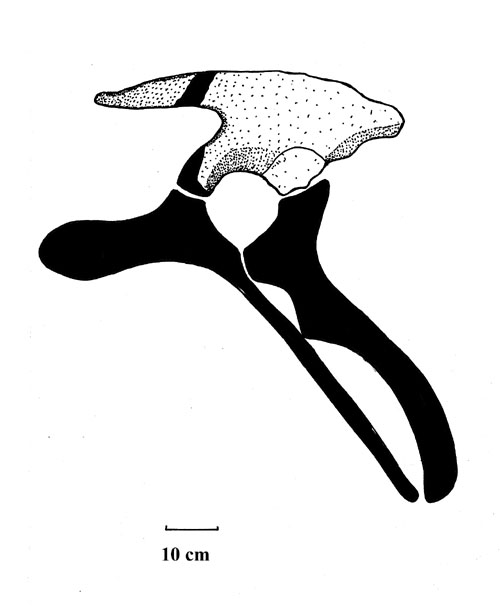
Genus: Hypselospinus NORMAN, 2010
Etymology: Greek, hypselos, "high/tall," and Latin, spina, "backbone"; in
reference to the singularly slender and elongate neural spines found on the
dorsal, sacral, and caudal vertebrae.
= Darwinsaurus PAUL, 2011
Etymology: In recognation of Darwin's theory, whith the diverse iguandonts standing
as an example of complex evoution via rapid speciation, And Greek, sauros, "lizard."
= Huxleysaurus PAUL, 2011
Etymology: For Dawin's "Bulldog" and coiner of the term agnostic, Thomas
Huxley, and Greek, sauros, "lizard."
= Wadhurstia CARPENTER & ISHIDA,
2010
Etymology: In reference to the Wadhurst Clay, Hastings Beds Group.
Species: fittoni (LYDEKKER, 1889) NORMAN, 2010
= Iguanodon fittoni LYDEKER, 1889
Etymology: In honor of William Henery Fitton (1780-1861).
= Wadhurstia fittoni (LYDEKKER,
1889) CARPENTER & ISHIDA, 2010
= Huxleysaurus fittoni (LYDEKKER, 1889) PAUL, 2011
Holotype: NHMUK (BMNH) R1635
Locality: Shorden Quarry in the Village of Shornden, near Hastings, East Sussex County, England, Southern United Kingdom.
Horizon: Wadhurst Clay Formation, Hastings sub-group, Lower Wealden Group.
Biostratigraphy:
Age: Lower Valanginian Stage, Middle Neocomian Subepoch, Lower Early Cretaceous Epoch, Early Cretaceous.
Material: Left ilium

NHMUK (BMNH) R1635a: Fragmentary pubis.
NHMUK (BMNH) R1635b: Fragmentary sacrum.
NHMUK (BMNH) R1635c: Caudal centrum.
NHMUK (BMNH) R1635d: Fragmentary upper teeth.
Referred material:
BENTON & SPENCER, 1995
Locality: Hare Farm Lane, Brede, (TQ 83141844), East Sussex County, England, Southern United Kingdom.
Horizon: Basal Wadhurst Clay, Lower Wealden Formation.
Biostratigraphy:
Age: Lower Valanginian Stage, Middle Neocomian Subepoch, Lower Early Cretaceous Epoch, Early Cretaceous.
Material:
NHMUK (BMNH) R1627: A partial pelvis, several dorsal and caudal vertebrae, a partial hind limb and other elements.
LYDEKKER, 1890
Locality: Hastings, East Sussex County, England, Southern United Kingdom.
Horizon: Wadhurst Clay, Lower Wealden Formation.
Biostratigraphy:
Age: Lower Valanginian Stage, Middle Neocomian Subepoch, Lower Early Cretaceous Epoch, Early Cretaceous.
Material:
BMNH: Right ilium, pubis, left femur, and several more or less imperfect vertebrae.
= Darwinsaurus evolutionis PAUL, 2011
Etymology: In recognation of Darwin's theory, whith the diverse iguandonts standing as an example of complex evoution via rapid speciation.Holotype: NHMUK R8131/1833/1835/1836
Locality: Shorden Quarry in the Village of Shornden, near Hastings, East Sussex County, England, Southern United Kingdom.
Horizon: Wadhurst Clay Formation, Hastings sub-group, Lower Wealden Group.
Biostratigraphy:
Age: Lower Valanginian Stage, Middle Neocomian Subepoch, Lower Early Cretaceous Epoch, Early Cretaceous.
Material: Fragmentary skull and fragmentary skeleton.
= Huxleysaurus hollingtoniensis (LYDEKKER, 1889) PAUL, 2011
= Iguanodon hollingtoniensis LYDEKKER, 1889
Etymology: In reference to Hollington, East Sussex County, England.Holotype: NHMUK (BMNH) R1148, R1629, R1632, 811, 811b, 604
Locality: Hollington, near Hastings, East Sussex County, England, Southern United Kingdom.
Horizon: Wadhurst Clay, Lower Wealden Formation.
Biostratigraphy:
Age: Lower Valanginian Stage, Middle Neocomian Subepoch, Lower Early Cretaceous Epoch, Early Cretaceous.
Material: Femur, sacral vertebrae.
Broken down by LYDEKKER, 1890
NHMUK (BMNH) R1148: Right femur.
NHMUK (BMNH) R1629a: Fragmentary scapula.
NHMUK (BMNH) R1629b: Crushed left radius and ulna.
NHMUK (BMNH) R1629c: Phalangeal spine of pollex.
NHMUK (BMNH) R1629d: Left femur.
NHMUK (BMNH) R1629e: Fragmentary left tibia.
NHMUK (BMNH) R1629f: Proximal portion of left fibula.
NHMUK (BMNH) R1629g: Second left metatarsal and the associated proximal phalangeal.
NHMUK (BMNH) R1632: 10 associated imperfect sacral and caudal vertebra.
NHMUK (BMNH) R1632a: 3 imperfect and much crushed cervical vertebrae and the distal portion of a metatarsal.
NHMUK (BMNH) R1632b: Terminal phalangeal of the second digit of the left pes.
Referred material:
NHMUK (BMNH) R811: Sacral vertebrae.
NHMUK (BMNH) R811b: Ilium.
NHMUK (BMNH) R 604: Dorsal vertebrae.
NHMUK (BMNH) R604: 3 fragmentary teeth.
NHMUK (BMNH) R604: A fragmentary right tibia.
NHMUK (BMNH) R604: A second left metatarsal.
NHMUK (BMNH) R604a: First phalangeal, belonging to a 2nd digit of the right pes.
NHMUK (BMNH) R604c: Second phalangeal of the third digit of the pes.
NHMUK (BMNH) R604b: A terminal phalangeal of the 2nd digit of the right pes.
NHMUK (BMNH) 33: Fragmentary skeleton.
Locality: Shornden, near Hastings, East Sussex County, England, Southern United Kingdom.Horizon: Wadhurst Clay, Lower Wealden Formation.
Biostratigraphy:
Age: Lower Valanginian Stage, Middle Neocomian Subepoch, Lower Early Cretaceous Epoch, Early Cretaceous.
Material:
NHMUK (BMNH) R 1636: Fragmentary skeleton.
NHMUK (BMNH) R1634: A middle dorsal vertebra.
Locality: Speeton Clay, Yorkshire County, England, Southern United Kingdom.
Horizon: D7D, Speeton Clay.
Biostratigraphy: Paracraspedites and Suberacraspidites zone.
Age: Late Berriasian Stage, Lower Neocomian Subepoch, Lower Early Cretaceous Epoch, Early Cretaceous.
Material:
NHMUK (BMNH) R8676: Right femur, tibia with attached astragalus and partial fibula.
Note: Has a pathology on the distal part of the shaft of the tibia (GALTON, 2009)